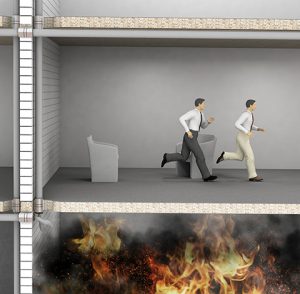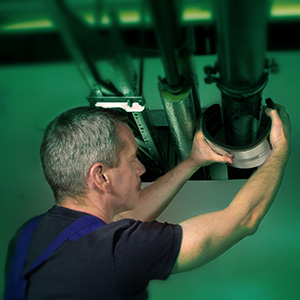Passive fire protection (PFP) is a form of safety provision that remains dormant or inert during normal conditions but becomes active in a fire situation. It is an integral component of  structural fire protection in a building, which is designed to contain fires or slow their spread.
structural fire protection in a building, which is designed to contain fires or slow their spread.
The purpose of PFP is to contain the spread of fire for sufficient time to permit i) the safe evacuation of all occupants of the premises and ii) the arrival of the fire brigade.
PFP provision is required in all buildings, whether domestic or non-domestic. Any new build / modernisation / extension works must be carried out in accordance with The Building Regulations 2010, Fire Safety, Approved Document B. Full details can be found on the Gov.uk website here.
In respect of the protection of openings and fire-stopping in order to inhibit the spread of fire, 10.2 of the Regulations states:
‘If a fire-separating element is to be effective, every joint or imperfection of fit, or opening to allow services to pass through the element, should be adequately protected by sealing or fire-stopping so that the fire resistance of the element is not impaired.’
There are two main types of opening that could compromise the integrity of a fire resistant structure: openings for pipes, and ventilation ducts, flues, etc.
Every service that is installed in a building, such as water pipes, electrical sockets, cable trunking and lighting units, can compromise the fire resistance of a room by creating openings in its walls, floor and ceiling. The role of PFP is to seal the gaps these penetrations create should a fire break out. All products designed to fulfil this criteria are fire rated, i.e. certified to resist fire for a specified length of time, which can be anything from 30 minutes to 4 hours. They all include an intumescent material, which remains dormant, or passive, during normal conditions but swells to many times its original size when exposed to the heat of a blaze.

It’s important to ask for advice as early as possible on the best way to deal with the fire protection of your project. It is surprising how frequently, after the installation of fire protection systems, everything has to be replaced because a part is used which is not up to the right fire safety standard or it has not been installed correctly.
Walraven has a range of products tested and certified suitable for dealing with passive fire protection of pipe penetrations through floors and walls. Our range of Walraven Pacifyre® MK II Fire Sleeves are suitable for both plastic and metal pipes. They have been extensively tested by independent authorities in various countries throughout Europe and are incredibly easy to install without the need for special fixing materials. Not only do they prevent the spread of fire, but they also provide a smoke and noise barrier whilst still allowing pipes to expand and contract. Contact us to find out more about dealing with passive fire protection.